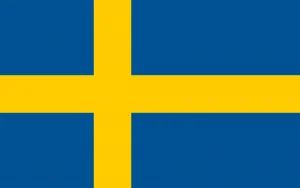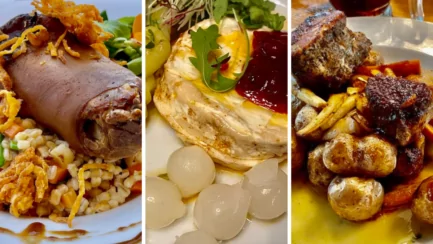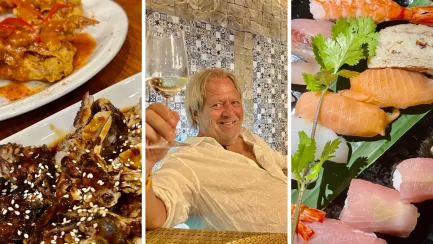Table of contents
Guest writer: Mia Ulin
The hottest food destination you can travel to right now is Palma de Mallorca. Not just because Ingrosso's La Perla restaurant is located in Palma, but because of all the fantastic Spanish ingredients and dishes you can taste in this small city in the middle of the Mediterranean. Join journalist Mia Ulin and chef Magnus Körnegård for some intense food days.
If you want to go to a big city in Europe, but still have access to sun and sea, Palma de Mallorca is perfect. Many people fly there, but you can also take a train down to Barcelona and then a boat across to Mallorca.
Palma is about the size of Malmö and has a history dating back to Roman times. For a time, Palma was Moorish, but since the end of the 15th century, when modern Spain was founded, Mallorca has also been Spanish.

Life is lived outside
You might think that Mallorca is the mother of all charter destinations, the first charter holiday from Sweden came here back in 1955, and as such would be completely over-exploited and overrun with tourists. But Palma in November is mostly made up of Mallorcans. Young people, the elderly and families alike pack the city's bars and pubs at all hours of the day and night.
Because you eat and socialise outside in Palma. From breakfast through morning coffee, lunch, afternoon coffee, la hora de vermuth (the vermouth hour) and dinner for the late night drinkers.


We chose not to have a hotel breakfast so after the morning training we head out into the nearest neighbourhoods and choose three different breakfast cafes for our three mornings. Day one is a toasted sandwich with avocado, tomato and fried egg on Tuduri Patisseria on the pedestrianised street near the hotel.
On day two we choose a simple but super tasty "boqadillo con queso y jamon serrano", that is, Spanish baguette with Spanish flavoured cheese and the local air-dried Serrano ham together with coffee con leche, the same as the Italian café latte but even tastier. You can get these sandwiches everywhere, we chose Ben Davant Bar, a super small local café with a nice service.
The café Indico la Primavera is located in a small square at Basilica of Sant Miquel (St Mikale's Church) and on day three we order two fantastic avocado, tomato and salmon sandwiches along with café con leche.

The white pedestrianised street
We fall in love with the little pedestrianised street Carrer de Blanquerna (roughly "white street") that runs from Avinguda del Comte de Sallent up to Plaça de Paris, about 1 km. Here you will find everything from fine restaurants to simple bars that you can stroll past and sit down for tapas or drinks.
The first evening we choose a small bar with simple tapas, El Zaguán, which we chose at the end of the trip for the bar with by far the best sangria. The nice thing about this part of Palma is that not everyone speaks English, so here we had to use our school Spanish to order which increased the sense of authenticity.
Our favourite is Café and Restaurant Sibil-la with really good Fish Taco, tapas as well as main courses and salads, many different cocktails, perfectly okay sangria, well made classic desserts like tiramisu and crème brûlée and ensaimada, a sweet spiral-shaped pastry dusted with icing sugar that originated in Mallorca. Here it is served with fresh strawberries and vanilla and chocolate ice cream.




Ansett matmecka
Palma is increasingly recognised as a food mecca with local produce and wines. Not least, the seafood is of a high standard. Those of us who live in Sweden have probably heard of La Perla, the restaurant in Palma harbour owned by the couple Emilio and Åsa Ingrosso, which is a fusion of Italian and Swedish and has received very good reviews. But we want to eat Spanish and Majorcan.
There are several market halls and food markets in Palma, the market halls are open every day and the food markets on different days.
For almost fifteen years there has been an organic food market at Plaça de las Patins where local farmers sell their home-grown fruit, vegetables, bread, pastries and oils. It is open in the mornings on Tuesdays and Saturdays.
Market hall with a large selection
The largest market hall is Mercado de Santa Catalina near the harbour but we stuck to Mercat de l'Olivar near Plaça d'Espana.

There is a huge range of produce here; fish, seafood, fruit, vegetables, pickled delicacies in bulk, meat, ready-to-cook, hams, sausages and countless cheeses. Most of it is locally sourced from Mallorca, the smaller neighbouring island of Menorca or one of Spain's many food districts.


There are also many bars in the market hall where you can eat the local produce cooked and drink local wines, cava and beer with it. Or why not try a Spanish vermouth, a strong red wine flavoured with wormwood, which is an excellent aperitif for tapas and has become very popular again in Spain.
We sit down at one of the biggest tapas bars, Corner 37, with fresh oysters and cooked prawns in garlic, scallops, squid of various varieties, tartars and sushi. To this we drink a Cava Mistinguett from the family-owned vineyard Vallformosa i Vilobi del Penedés outside Barcelona.

Palma has a large harbour where huge cruise ships dock for a day or two on their tours around the world. Next to us are two upper-middle-aged couples who, like us, are feasting on the savoury delicacies of the sea and the earth. They tell us they are from Israel and have embarked on a long cruise to the Caribbean. "Because there's a war going on." We all have different ways of dealing with life's challenges.
Exclusive neighbourhoods
Wandering the medieval alleys of Palma's old town near the cathedral is an experience that can go on for hours. As well as restaurants, bars and cafés, there are boutiques selling clothes, shoes, jewellery, jewellery, wine, pastries and delicacies.
Paseo del Borne is one of Palma's most exclusive avenues lined with brand-name boutiques like Louis Vuitton, Carolina Herrera, Bvlgari, Rolex and Mulberry. If you have the right approach, you will surely be invited for a glass of Champagne while trying on a pair of trainers at Louis Vuitton for €1000.
The centre is a ballroom-style promenade with many benches and outdoor cafés offering oysters, Champagne and other delicacies. Sitting down here for your afternoon drink at Born 8, Bar Bosch, Le Siesta or any of the other outdoor cafés is a must to feel the pulse of Palma.


Bakery as a bedtime story
On the cross street around the corner of Paseo del Borne is the lovely street Carrer Unió with one of the best-stocked delicatessens in Mallorca, Majorca Delicatessen Mateu Pons. There you will be invited to all sorts of delicious sausage flavours.

Next door you have the bakery El Fornet de la Soca, located in the historic premises "Forn de Teatre" which is one of the most special bakeries we've been to. The name comes from a bedtime story that owner Tomeu Arbona and his wife María José used to tell their children, and both the ornate Art Nouveau façade and the interior are straight out of an early 20th-century fairy tale.
The owners do a lot of research into traditional Mallorcan gastronomy and products found in old recipe books. Among other things, you can buy at least five different types of bread baked daily with original Majorcan flour and a wide range of sweet and savoury pastries.

El Camino tapas bar
The highlight of our food trip was the tapas bar El Camino on Carrer Brondo. The restaurant has been written about internationally and especially in Sweden, so you are advised to book a table several weeks in advance.
We are lucky enough to get two seats at the bar at 14:00, where you should sit for the maximum experience. The bar seats around 25 people, and behind it is a fantastic spectacle as the eight chefs and six waiters do their very best to give their guests an unforgettable gastronomic experience of Spanish cuisine.


We start with an irresistibly appetising tuna tartare served with avocado mousse and topped with sesame seeds and olive oil.
The large, beautifully red, deep-sea prawns known as Carabineros are caught by small-scale fishing off the coasts of Mallorca and southern Spain. They are salted and grilled, have a distinctive flavour and a firm flesh.
Small, flavoursome scallops, known as zamburinas or queen scallops, are served grilled with herbs in their shells.
We accompany the seafood with grilled thin broccoli stalks, heart salad wedges topped with anchovies and small flakes of Panceta Iberica and a beautiful deep-fried courgette flower filled with rich goat cheese cream.



The Spanish Iberian pig
The only meat dish we order is Pluma Iberica, a marbled and flavoursome cut of pig called kotlettkappa in Swedish, which is very good for grilling. Black Iberico pigs originate in Spain and some of them are raised on acorns. It is from the Iberico pigs that the famous air-dried ham pata negra comes.

With all the dishes we drink an organically grown cava from Mallorca called Cava Tutumba, a play on words that in Spanish means "dig your own grave" but which hardly gives us a sense of burial, rather the opposite.
We choose to share all the dishes, which are plentiful, except the prawns, which are ordered per piece. Two hours later, after both taste sensations and wonderful meetings with other diners from Stockholm, Gothenburg, Malmö and Paris, the bill for two people ends up at € 177, that is, just over SEK 2000. One of the more expensive lunches I've had, but we all agreed that it was worth every euro.
We know we've only scratched the surface and that there are plenty of food, drink and cultural experiences left in Palma and the surrounding area, and we're saving that for next November.
Facts about Palma
Season and temperature - We choose to go to Palma in early November, when it is still Swedish summer heat in Mallorca. It rarely gets colder than plus 8 degrees, in January to March, and both November and December are very pleasant. We sat outside and ate dinner in just a shirt and dress every night around 8pm and the temperature was 25 - 27 degrees during the day.
Distance - Since we want to stay in the city centre, we choose a hotel in the more modern areas near the hub Plaça de Espana, about 1.5 km from the sea and the cathedral. It takes about 20 minutes to walk down, and we are always right in the centre. There are buses directly from the airport which is only 20 minutes drive from the hotel. A single bus journey costs €5, taxi €20. As soon as you step outside the hotel doors, there are cafes, restaurants and bars galore, wherever you go.
Accommodation - Cost per person 4 nights in a 4-star hotel in early November max 1.7 km from Palma city centre, by the sea or in the city: From 3,400 kr.
Travel - Flight Arlanda - Palma about 3,5 hours. Train Stockholm Barcelona 38 hours with night train or 2-3 days with overnight stay. Boat Barcelona - Palma about 8 hours.
Bathroom - Palma is not primarily a place for sunbathing and swimming, although there are plenty of opportunities. Choose a hotel with a swimming pool. The nearest beach is C'an Pere, about 2 km from the centre of Palma. Close to the beach there are many restaurants for lunch. Playa de Illetes takes about 1 hour by bus or 15min by car/taxi from the centre.
Excursion - If you stay a little longer in Palma, we recommend a trip to Port de Sollér, with a stop in the village of Sollér, a very cosy fishing port with a sandy beach about 3 miles north. You travel by public transport with a beautiful antique wooden train for about 1 hour departing from Plaça de Espana, by bus or by car for about 40 minutes. A great journey that costs around €7 single ticket.
Attractions -The main attraction in Palma is the cathedral La Seu, which is a magnificent landmark down by the sea with the old medieval alleys around it. If you want to combine your culinary experiences with culture, the surrealist artist, graphic designer and sculptor Juan's Mirós home, now expanded into a modern, high-class art centre. Travelling to the Funació Juan Miró Mallorca art gallery takes about 15 minutes by car or taxi, about €13, or 45 minutes by bus. Admission €10 per person.


Wine tastings - If you are a little extra interested in the local wine, you can book a wine tasting. We didn't have time this time, but we were recommended Avinae Wine & Spirits in the old town. At avinae.es you can book wine tastings from €58 per person. Carrer de Llums 3.



















